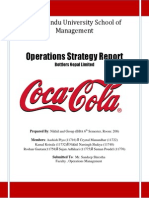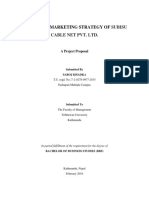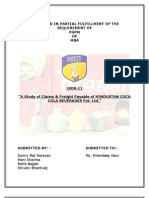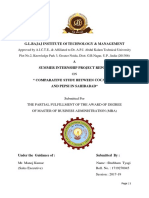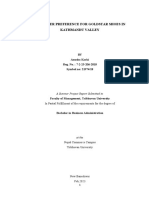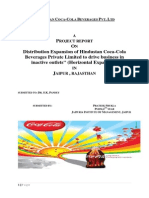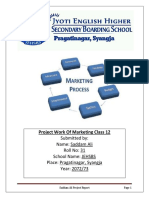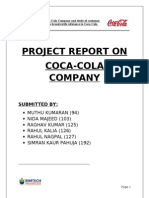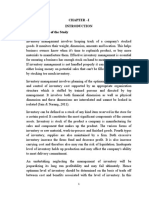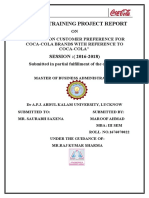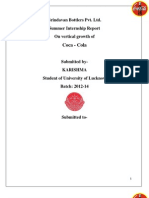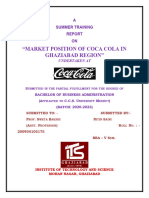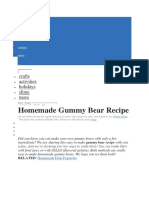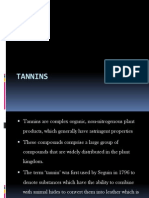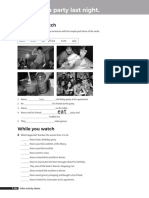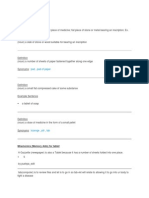ANALYSIS OF MARKETING CONCEPT AT
BOTTLERS NEPAL LIMITED
By
Anjish Maharjan (LC00015001195)
Pooza Karmacharya (LC00015001229)
Samikshya Maharjan (LC00015001256)
Shristi Hirachan (LC00015001270)
A Report Submitted in the partial fulfilment of
The requirement for the degree of
MASTER OF BUSINESS ADMINISTRATION (MBA)
At the
Institute of International Management Science
Lincoln University College, Malaysia
Faculty of Business and Accounting
Kathmandu, Nepal
25th September 2021
� RECOMMENDATION
This is to certify that the this Report
Submitted By
Anjish Maharjan
Pooza Karmacharya
Samikshya Maharjan
Shristi Hirachan
Entitled
ANALYSIS OF MARKETING CONCEPT AT
BOTTLERS NEPAL LIMITED
has been prepared as assigned by the requirement of the course MARKETING
MANAGEMENT in the prescribed format of the Faculty of Business and Accountancy,
Lincoln University College. This Report is submitted for further grading of the course.
Submitted to
Dr. Gopal Thapa
…………………………….
Date: …………………………
i
� ACKNOWLEDGEMENT
The report has been completed from the help, support and encouragement of a number of
people and we want to acknowledge them here.
Firstly, we would like to thank Lincoln International University and IIMS College for the
wonderful opportunity it has provided by including the practical world as a subject matter,
which has helped us explore ourselves.
Secondly, we would like to thank Dr. Gopal Thapa for his continuous guidance, encouragement
and constructive comments throughout the course and report preparation.
Also, we would like to thank all the people who have supported us and encouraged us in the
course of preparing this report. We hope that this report reflects our efforts to cover all required,
relevant, and crucial material and the research topic.
Sincerely,
Anjish Maharjan
Pooza Karmacharya
Samikshya Maharjan
Shristi Hirachan
ii
� DECLARATION
We, hereby declare a research project entitled “Analysis of Marketing Strategy of Bottlers
Nepal Limited” submitted to Lincoln International University is our genuine work done
originally carried out in the year 2021. It is done for partial fulfilment of the requirement
of MBA under the supervision of Dr. Gopal Thapa, Lecturer, at IIMS College. This report is
purely for academic purposes, the work is done, and information is reliable and accurate as far
as the knowledge of the study.
Signature,
Anjish Maharjan
Pooza Karmacharya
Samikshya Maharjan
Shristi Hirachan
iii
� Table of Contents
Recommendation ........................................................................................................................ i
Acknowledgement .....................................................................................................................ii
Declaration ............................................................................................................................... iii
1. Introduction of the Company .............................................................................................. 1
2. marketing, sales, and distribution ....................................................................................... 1
3. Brands Under COCA-COLA.............................................................................................. 2
4. Product Life Cycle .............................................................................................................. 3
5. Marketing Initiatives of the company................................................................................. 3
6. Strategies used by the company.......................................................................................... 3
7. Porter’s Five Forces Model of Coca-Cola .......................................................................... 4
8. Marketing Mix of Coca-Cola ............................................................................................. 5
9. PEST Analysis of Coca-Cola ............................................................................................. 9
10. SWOT Analysis of Coca-Cola ...................................................................................... 10
11. BCG MAtrix of COCa-Cola ......................................................................................... 10
Suggestions .............................................................................................................................. 11
Conclusion ............................................................................................................................... 11
References ................................................................................................................................ 12
iv
� 1. INTRODUCTION OF THE COMPANY
The Coca-Cola was introduced to the Nepalese market in 1973 by importing from India. In
1979, the local production of Coca-Cola started in Nepal. As of 2020, a publicly listed
company, Bottlers Nepal Limited (BNL), runs the production. There are two bottling plants,
one in Kathmandu and another in Bharatpur, which is known as Bottlers Nepal (Terai) Limited
which is 160 km from Kathmandu, its capital. Both are owned by BNL.
The Marketing, Sales & Distribution strategy for Bottlers Nepal Limited is entitled “Refresh
the Marketplace” and includes a robust Consumer Response System to address any
consumer/customer concerns, ideas, suggestions – either on product and its quality or on stock
supply maintenance of equipment etc. All consumer concerns are addressed in a fair, timely
and friendly manner, to satisfy them and resolve their concerns. As of June 2020, about 500
people work in the manufacturing plant.
Bottlers Nepal Limited is a Public Limited Company, with operations spanning over 41 years,
located in Balaju Industrial District (BID) Kathmandu. The plant has both RGB (Returnable
Glass Bottles) and PET packaging lines, producing different products from the portfolio to
serve consumers their favourite drinks at all times. The Bottlers Nepal Limited group continues
to be engaged in the production, manufacture, sale, distribution and supply of soft drinks being
carbonated non-alcoholic beverages, fruit juice and packaged drinking water under the brand
names Coca-Cola, Sprite, Fanta, Coke Zero and Kinley. The Bottlers Nepal Private Ltd.
changed into transformed to a public business enterprise in 2007 and is listed in the Nepal
Stock Exchange.
2. MARKETING, SALES, AND DISTRIBUTION
BNL's marketing, sales, and distribution approach is dubbed 'Refresh the Marketplace,' and it
includes a sophisticated Consumer Response System to address customer issues, ideas, and
suggestions. BNL is also committed to assisting the community through various programs,
mostly in the field of health. BNL also supports the local community by offering a free health
check-up clinic at the Bharatpur municipality.
The Company is considered as one of the most prestigious multinational companies in Nepal.
It believes the success of the Company depends on the ability to connect with consumers by
1
�providing them with a wide variety of beverage options to meet their desires, needs and
lifestyles. The success further depends on the ability of the people working there to execute
effectively, every day. Their objective is to use the Company’s assets, brands, financial
strength, unrivalled distribution system, global reach, talent and strong commitment of the
management and associates to become more competitive and to accelerate growth in a manner
that creates value for the shareowners.
Marketing is one of the most delicate aspects of product branding. Businesses frequently use
advertising to demonstrate how their product is superior to similar competitor products in terms
of benefits or effectiveness. When a company launches a new product, advertising is a great
way to get the word out to a big audience. Businesses employ advertising to achieve a variety
of objectives, and they advertise through a variety of mediums. Businesses advertise in media
that reach specific markets in addition to traditional venues such as newspapers and general
interest magazines. A portable communications gadget, for example, is advertised on a social
media site aimed for younger people.
3. BRANDS UNDER COCA-COLA
Coca-Cola has been extending its product line through addition of various products according
to its compatible market. Following are some of the brands under Coca-Cola:
All those products fall under the same industry i.e. Beverage Industry and they are contributing
for the growth of Coca-Cola Company.
2
� 4. PRODUCT LIFE CYCLE
The product is in its maturity phase in terms of lifecycle. The fact that the Coke has established
itself as a quality beverage brand all around the world and successfully captured the major
market share of the beverage industry ( even in Nepal), shows that the product is in its maturity
phase. Another aspect of the Coke like developing another product flavor(line) like Sprite,
Fanta and continuous promotion to reinforce the same perception of CocaCola is the things
normally done under maturity phase of the product. Finally, The competitors like Pepsi has
already established itself and there's a huge competition within these two beverage giants;
Again the common feature of product which is under its maturity phase.
5. MARKETING INITIATIVES OF THE COMPANY
a) REFRESH MAX MOBILE TIME CHILLAX: Two things can happen during your
mobile screen time…refresh or stress. Don’t get stuck between the two - grab a chilled
sprite & refresh your mobile time. This is one method the company is attempting to
attract attention by claiming that a bottle of cold sprite can assist a person stay cool
while using their phone.
b) Diusai Jhap Jhap, Coke Le Up.: The everyday afternoon slump often makes us miss the
most exciting moments of our life. But not anymore. With the uplifting taste of Coca-
Cola, turn up your energy, turn up your mood, turn up your rhythm, turn up your day!
Go Ahead, Grab that Chilled Coke And OWN those moments! This method makes the
customers by helping them reminisce the fun moments that they have missed in their
life.
c) Khana J Hola, Swad Bhadhauna Coca-Cola: When a group of friends are having regular
food and Coca-Cola joins in on the table, the group turns into a squad and the simple
talk can turn into something memorable. Whatever food a group of person consumes,
addition of Coca-Cola adds spice to their food.
6. STRATEGIES USED BY THE COMPANY
Marketing strategy is a commonly used term, but no one is really sure what means is. “A
strategic sector is one in which you can obtain a competitive advantage and exploit strategic
3
�sectors are the key to strategy because each sector’s frame of reference is competition. The
largest competitor in an industry can be unprofitable if smaller competitors dominate the
individual strategic sectors.
Bottlers Nepal ltd under the authority of The Coca-Cola Company focuses on the poduct
differentiation strategy. Apart from the secret formula that is directly obtained from the parent
company which helps to maintain the differentiation of the product (Coke) from operations
view point, The overall marketing strategy of Coke also adds on to differentiate their brand and
product perception into the mind of customer. For instance, Coca cola (BNL plant) successfully
markets Coke not just any beverage product, but something that spreads happiness within the
consumer's life. It has successfully established itself as the complementary part of people's life
and continuously reinforces the same belief
7. PORTER’S FIVE FORCES MODEL OF COCA-COLA
a) Bargaining Power of Suppliers
Most of the ingredients needed for beverages and snacks are basic commodities such
as potatoes, flavor, color, caffeine sugar, packaging etc. So the producers of these
commodities have no bargaining power over the pricing for this reason; the suppliers
in this industry are weak.
b) Bargaining Power of Buyers
Buyers in this industry have the bargaining power, because main source of the revenue
and market share in beverage and food industry are fast food fountain, convenience
stores food stores vending etc. The profit margins in each of these segments noticeably
demonstrate the buyer power and how special buyers pay diverse prices based on their
power to bargain.
c) Threat of New Entrant
There are many factors that make it hard for new player to enter the beverage industry
some of important factors are brand image and loyalty, advertising expense, bottling
network, retail distribution fear of retaliation and global supply chain.
d) Threat of Substitute Products
4
� Large numbers of substitutes are available in the market such as water, tea, juices coffee
etc. However, firms counter them with innovative marketing and massive advertising,
which build growth for their brands by highlighting their benefits. Players also
differentiate themselves by well-known global trademarks, brand equity and
availability of the products which most of the substitute products cannot contest. To
protect themselves from competition players in soft drink industry offer Diversify
products such as Pepsi offers soft drinks (Pepsi, Slice, Mountain Dew), beverages
(Tropicana Juices, Dole Juices, Lipton tea, , Sport drinks, Tropicana Juices), Snacks.
Coke also offers most diversified range of products such as Diet Coke, Coca-Cola and
range of lime or coffee and lemon.
e) Competitive Rivalry within an Industry
Beverage industry competition can be classified as a Duopoly with Pepsi and Coca
Cola. The market share of other competitors is too low to encourage any price wars.
Cola-Cola gets competitive advantage through the well-known global trademarks by
achieving the premium prices. It means Cola-Cola have something that their
competitors do not have. While Pepsi has leveraged its worldwide brand-building
strength to attach with consumers in significant ways and impel the growth globally
8. MARKETING MIX OF COCA-COLA
Firstly, we will look at how Coca-Cola has used their marketing mix. The marketing mix is
divided up into 4 parts; product, price, promotions and place.
a) Product: The product (Coca-Cola soft drink) includes not just the liquid inside but also
the packaging. On the product-service continuum, we see that a soft drink provides little
service, apart from the convenience. Soft drinks satisfy the need of thirst. However,
people are always different, some want more and others want less. Therefore, Coca-
Cola has made allowances for that by providing many sizes. We also have particular
tastes, and again they have provided several options. So, although thirst is what is
needed to be satisfied and that is the core benefit, we are receiving other benefits in the
taste and size.
Coca-Cola has developed several different flavours and sizes as mentioned above, but
also several brands such as Sprite, Lift, Fanta and Diet Coke which increase the product
5
� line length, thus making full use of the market to maximize sales. The product is
convenient, that is - bought frequently, immediately, and with a minimum of
comparison and buying effort. The appearance of the product is eye catching with the
bright red colour. It has a uniquely designed bottle shape that fits in your hand better,
and creates a nicer & more futuristic look. The quality of the soft drink is needed to be
regularly high. Sealed caps ensure that none of the "fizz" is lost. The bottles are light,
with flexible packaging, so they will not crack or leak, and are not too heavy to casually
walk around with. The cans are also light and safe.
The product range of Coca-Cola includes:
Coca-Cola,
Coca-Cola classic,
Diet Coke
Diet Coke with lemon
Fanta brand soft drinks
Sprite,
b) Place: Coca-Cola entered foreign markets in various ways. The most common modes
of entry are direct exporting, licensing and franchising. Besides beverages and their
special syrups, Coca-Cola also directly exports its merchandise to overseas distributors
and companies. Other than exporting, the company markets internationally by licensing
bottlers around the world and supplying them with the syrup needed to produce the
product. There are different types of franchising. The type that is used by Coca-Cola
Company is manufacturer-sponsored wholesaler franchise system. It is very
comparable to licensing but the only difference is that the finished products are sold to
the retailers in local market. Coca Cola has managed their company’s marketing and
sales strategy within channels. The Coke Company operates three primary delivery
systems for its business channels:
Bulk delivery for the channels of large Supermarkets, Mass Merchandisers and
Club stores;
For smaller channels Coke does advanced sale delivery for convenience stores,
drug stores, small supermarkets and on premise fountain accounts.
Full service delivery for its full service-vending customers. Key Channel
Listing
6
� Supermarkets
Convenience Stores
Fast Food
Hotels/Motels/Resorts
c) Price: Like any company who has successfully endured a century of existence, Coca-
Cola has had to remain tremendously fluent with their pricing strategy. They have had
the privilege of a worthy competitor constantly driving them to be smarter, faster, and
better. A quote from Pepsi Co's CEO "The more successful they are, the sharper we
have to be. If the Coca-Cola Company didn't exist, we'd pray for someone to invent
them." states it simply. The relationship between Coca-Cola & Pepsi is a healthy one
that each corporation has learned to appreciate. Throughout the years, Coca-Cola has
made many pricing decisions but one might say that their ultimate goal has always been
to maximize shareholder value. As Cola consumption has decreased in the US Colas
have come to realize the untapped international market.
When people buy Coca-Cola they are not just buying the beverage but also the image
that goes with it, therefore to have the price higher reiterates the fact that the product is
of a better quality than the rest and that the consumer is not cheap. This is known as
value-based pricing and is used by many other industries in attracting consumers.
d) PROMOTION: With the worldwide operation, Coca-Cola Company has gain a lot of
popularity. It has also been successful in Nepal and maintained a large market share in
beverage industry. Promotion mix is a combination of communication tools such as
personal selling, advertising, sales promotion, public relation and direct marketing. It
focuses on using best combination of promotional tools to promote the product to the
target market.
Entitled as “Refresh the Marketplace” the marketing, sales and distribution strategy for
Bottlers Nepal Limited include a robust Consume Response System to address any
consumer/ customer concerns, ideas, suggestions either on product and its quality or on
stock supply, maintenance of equipment, etc. The company makes sure to deal all
7
� consumer concerns with a fair, timely and friendly manner so as to satisfy them and
resolve their concerns.
Towards the promotion of the product, Bottlers Nepal Ltd. uses following promotional mix:
i) Advertising:
It is paid form of promotional tool.
Indoor media such as newspapers, magazines, radio, television, etc.
Outdoor media such as hoardings, truck backs, wall paintings, etc.
Picture: Wall Painting Picture: Hoarding Board
ii) Sales Promotion:
It consists of diverse collection of incentive tools, mostly short term, designed to
generate heavy sales volume.
POS (Point-of-sale)
Consumer contests such as offering some kind of reward like money, free ticket,
smartphones, etc.
8
� iii) Public Relation:
It involves variety of program designed to promote and protect company’s image.
News releases such as building a fully automatic Effluent Treatment Plant (ETP) in
each of its plants to protect and preserve local environment.
Sponsorship of social events such as football competition, donation program, etc.
9. PEST ANALYSIS OF COCA-COLA
As the leading beverages company in the world, Coca Cola almost monopolizes the entire
carbonated beverages segment. Beside it, Coca Cola also maintain their reputation as the
leading company in the world using PEST Analysis so that Coca Cola can examine the macro-
environment of Coca Cola’s operations.
a) Political: When Coca Cola had decided to enter a country to distribute the products,
Coca Cola was monitoring the policies and regulations of each country. For the
example, when entering Moslems country such as Indonesia or Malaysia, Coca Cola
followed the regulation by adding “Halal” stamp in each Coca Cola’s products. In this
case, Coca Cola has no political issues in this matter.
b) Economic: Coca Cola also has low growth in the market for carbonated beverages
(North America). The market growth was 1% in 2004. For stimulating the growth, Coca
Cola had spent high budget of advertisement to endorse the customers.
c) Social: Nowadays, customers tend to change their lifestyle. Customers more aware
about health consciousness by reducing in drinking carbonated beverages to prevent
diabetes or other diseases. As a result, Coca Cola’s demand for carbonated beverages
has decreased and the revenues decreased. Thus, Coca Cola diversify the products by
adding production lines in tea (Nestea), juices (Minute Maid), mineral water (Dasani
and Ades), and sport drinks (Powerade), and others.
d) Technological: Because of the developing technology, Coca Cola has advanced
technology in producing the products. Then, Coca Cola made innovations by giving
flavors to the Coke, such as Cherry Coke, Diet Coke, Coca Cola Zero, Coke with Lime,
and others. However, the customers still prefer the original taste of traditional Coke; it
can be seen by the high demands in traditional Coke.
9
� 10. SWOT ANALYSIS OF COCA-COLA
Strengths Weaknesses
Carbonated soft drinks growth 10- Weak infrastructure (esp. Cooling)
15% Small retailers, less shelf space
Estimated PCC to increase to 6-8 Problems of empty bottles
bottles
Opportunities Threats
Growing rural market internecine Political Risks
competition Coke and Pepsi indulging in soft
Rising Disposable income drink market
Changing consumer taste and
preference
11.BCG MATRIX OF COCA-COLA
a) Cashcows: Cashcows are the products that have a high market share in a market that
has low growth. Below are few products which have been the cash cow for the company
for all these years:
Coke: Coke for years has been a market leader in carbonated soft drink segment and a
major cash generator for the company. Having a presence in 200+ countries, coke has
been the no.1 choice for millions of consumers all these years when it comes to
choosing a carbonated soft drink.
b) Stars: The products or business units that have a high market share in high growth
industry are the stars of the organization. Kinley: Kinley is still bottled water brands
owned by Coca-Cola and offered in different markets.
c) Question Mark: With an aim to cater to the changing needs of consumers to zero
calories and no sugar drinks, Coca-cola company has launched a number of
products/brands to cater the same. The company is investing a lot of capital to create
awareness about these brands. These products/brands are still in the initial/development
phase of the product lifecycle and have a huge potential to grow. Diet Coke, Sparkling
water, Minute Maid are few brands/products which fall under the Question Mark
quadrant.
d) Dogs: Dogs are those products that were perceived to have the potential to grow
however failed to create magic due to the slow market growth. Coke – Declining
demand for carbonated soft drinks due to increasing demand for low calorie and healthy
beverages and snacks is what is attributing the diminishing sales of Coke brand. Coke
brand which is currently regarded as a cash cow for the company will eventually fall in
quadrant in the future due to all these factors.
10
�SUGGESTIONS
Following are some of the suggestions that Coca-Cola Nepal can consider:
1. Perform a detail demand survey at regular interval to know about the unique needs and
requirement of the customer
2. The company should focus to bring some more flavors like health drinks and other low
calories offerings. Coca cola can also introduce some fruit based drinks to enter the
energy drink arena.
3. The company must keep a watch on it primary competitors in market in order to be able
to compete with them
4. The company should use a new attractive system of word of mouth advertisement to
keep alive the general awareness in the whole market
5. The company should always be in a position to received a continuous feedback and
suggestion from its customers as well as from the market and try to solve it without any
delay to established its own good credibility
CONCLUSION
The process of spreading happiness by the brand coke is indeed the simple process. Bottlers
Nepal Limited is making continuous efforts in its marketing strategy with fun, and creative
taglines that are able to capture the attention of people and stay in their minds. It has also been
introducing and marketing its new products effectively. People are aware of the Brand &
Awareness of Coca-Cola is quite high in the market. When a product is launched, avid Coke
drinkers choose this soda over any other competitor simply because it's a Coca-Cola product
and they trust it. Although Coke has been into controversies, people still prefer to stay loyal to
the Brand with Coca-Cola being termed as a more popular brand than Pepsi.
Coca-Cola products would appear, on the shelf, to have the most expensive range of soft drinks
common to supermarkets, at almost double the cost of no name brands. This can be for several
reasons apart from just to cover the extra costs of promotions, for which no name brands do
without. When people buy Coca-Cola they are not just buying the beverage but also the image
that goes with it, therefore to have the price higher reiterates the fact that the product is of a
better quality than the rest and that the consumer is not cheap. In supermarkets and convenience
stores Coca-Cola has their own fridge which contains only their products. There is little
personal selling, but that is made up for in public relations and corporate image. Coca- Cola
sponsors a lot of events including sports and recreational activities.
11
�REFERENCES
BNL. (2021). Retrieved from https://bnl.com.np/marketing-initiatives/
Boundless. (2020). Retrieved from Saylor.org:
https://learn.saylor.org/mod/page/view.php?id=8821
codes, H. (2018, September). Retrieved from https://heartofcodes.com/bcg-matrix-coca-cola/
Goyal, H. (2015). Marketing Strategy analysis of Bottlers Nepal Ltd.
Group, N. a. (2018). Operation Strategy Report.
Singh, T. (2016). MARKETING STRATEGIES OF COCA COLA.
12


